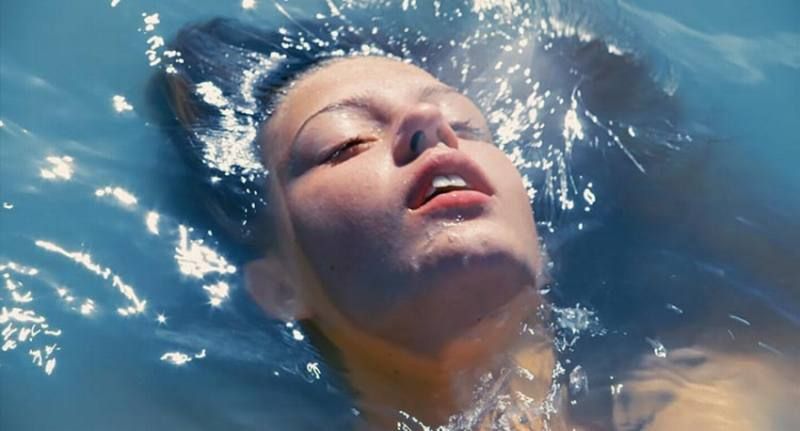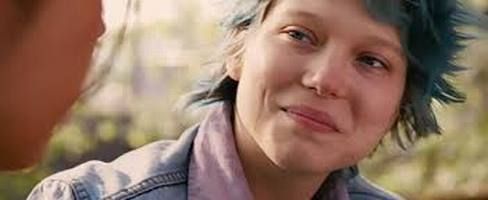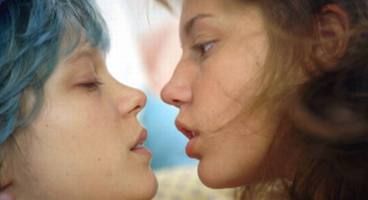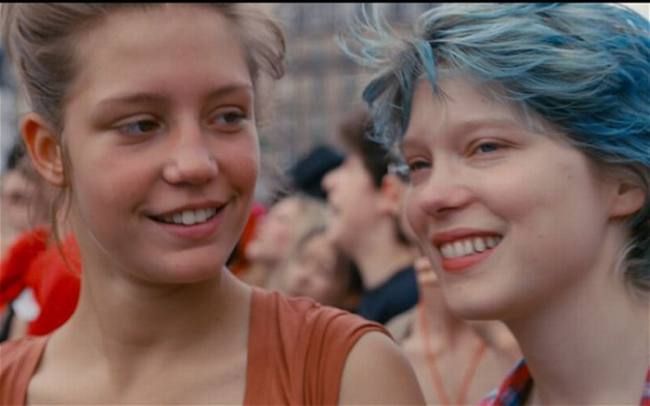← Back to Reviews
in
Blue is the Warmest Color
(Abdellatif Kechiche, 2013)
(Starring: Adéle Exarchopoulos; Léa Seydoux)

Blue is the Warmest Color--- perhaps better known by its alternate title, The Three-Hour Lesbian Movie; or, How I Learned To Stop Worrying and Love Cunnilingus--- is the most controversial movie of 2013. Why? Sex, baby! After all, it's not often that a NC-17 movie featuring explicit, extended scenes of muff-diving becomes a critical darling, racking up awards and appearing on multiple best-of-the-year lists, but this erotic French import deserves every accolade that it received. Viewers might have come for the sex scenes (wait, is that a pun?), but it's the tender, heartbreaking, achingly realistic love story at the core of Blue is the Warmest Color that gives the film its power.
In Blue is the Warmest Color, we witness the complete arc of a relationship--- from the fated glance to the awkward butterflies of a first kiss, from passionate intimacy to the fading embers of familiarity, to the shared experiences and compromises and arguments, the laughs and tears and heartbreak. It is about the molding of two people into one, followed by the emotional devastation of infidelity and the painful debris caused by the ensuing breakup. The 180-minute run-time breathes life into the relationship, since viewers get a level of nuance and painstaking realism that is very rarely seen in on-screen romances. This, along with the phenomenal performances and out-of-this-world chemistry between the two leading ladies, results in one of the most believable relationships I've seen in a movie.

(I know what you're thinking: "Does the carpet match the drapes?")
In addition to the romance, we're also privy to the honest, nuanced, beautifully told tale of a fresh-faced teenage girl's burgeoning sexuality and her confusing revelations about gender attraction and self-acceptance. Compare and contrast the differences in Adéle's demeanor when she's hit on by a boy, agrees to a date, has sex with him, yet fails to feel a spark, with the way she later blushes and grows flustered when a female peer flirts with her at school. The kiss with the boy is searching and empty and confusing, whereas the kiss with the girl is elating, eye-opening and exactly what she's been missing in her relationships with the opposite sex. All this leads to a late-night foray into a gay bar and our introduction to the blue-haired love interest named Emma. The attraction is immediate, and so is the chemistry. Whereas Adéle is shy and insecure, Emma is full of confidence and swagger. The dichotomy is perfect, with Emma's forwardness about her sexuality serving as a catalyst for Adéle's self-acceptance. The two girls strike up a conversation--- which, like all the conversations in the movie, is well-written, realistic, and entertaining to eavesdrop on--- and the seeds of a relationship are sown.
Blue is the Warmest Color isn't a Statement Movie. It isn't campaigning for gay rights or same-sex marriages. The fact that the relationship is between two young women is inconsequential. It is, however, a movie that takes place in the real world, so real world issues are going to arise. When Adéle's peers become suspicious of her friendship with Emma, they confront her in a verbal assault, embarrassing her in front of her classmates and reducing her to tears. The social stigma is also illustrated when Adéle lies to her parents about the true nature of her relationship with Emma. (In an example of the intelligent, nuanced script, we see the juxtaposition of child-rearing attitudes with both sets of parents and how their upbringing is reflected in the ideals and personalities of Adéle and Emma. For example, Adéle's parents are more conventional, more concerned with what's "concrete," so Adéle, despite Emma's urging to explore her artistic side and share her talented writing, feels the need to pursue a safer, more formal career; whereas Emma's parents are much more free-spirited, emphasizing creativity and artistic freedom, so Emma feels no need to hide her sexuality, kissing Adéle in front of her parents. Even the families' meals symbolize their differences.)

(Adéle and Emma get hot and bothered while watching an episode of The Smurfs.)
Unlike most love stories that complete their arc in under two hours, Blue is the Warmest Color has an extra hour with which to examine the inner-workings of its relationship. However, there's a good reason why most love stories roll the credits before the passion fades: it isn't that interesting to watch two people complacently in love. When the movie skips ahead to a later period in the relationship, much of the momentum is lost, and I started to feel the movie's length. This is before the relationship splinters and the film delivers its most powerful, heartbreaking, emotionally captivating scenes, all of which the two actresses knock out of the park. Afterwards, when we see Adéle dress in blue, it's not only representative of her mood, but a subconscious reminder of the love she has lost. The melancholic last scene hearkens back to the beginning and the metaphor with the missed bus (which was made more obvious by the subsequent classroom discussion about regret and missed opportunities in love). The warmest color may have lost its warmth, but its embers will never be extinguished.
What about those controversial sex scenes, though? After all, that's the sole reason many people will watch this movie. Are those scenes exploitative and distracting, as many have claimed? Or are they beautiful and necessary? They're certainly erotic, that's for sure, and what makes them feel unusual is their unorthodox length and fiery passion. My personal opinion is that all movies should contain a bit of cunnilingus (Transformers: Age of Foreplay), so I'm no prude, and I think the NC-17-rated scenes obviously helped the movie's visibility, since they garnered so much media attention. If a few scenes of women performing pap smears on each other with their tongues gets more people to watch this beautiful movie--- which is, in my opinion, one of the most passionate, tender, convincing love stories I've ever seen on film, with two of the best performances from 2013--- then those scenes more than served their purpose.

(Abdellatif Kechiche, 2013)
(Starring: Adéle Exarchopoulos; Léa Seydoux)

Blue is the Warmest Color--- perhaps better known by its alternate title, The Three-Hour Lesbian Movie; or, How I Learned To Stop Worrying and Love Cunnilingus--- is the most controversial movie of 2013. Why? Sex, baby! After all, it's not often that a NC-17 movie featuring explicit, extended scenes of muff-diving becomes a critical darling, racking up awards and appearing on multiple best-of-the-year lists, but this erotic French import deserves every accolade that it received. Viewers might have come for the sex scenes (wait, is that a pun?), but it's the tender, heartbreaking, achingly realistic love story at the core of Blue is the Warmest Color that gives the film its power.
In Blue is the Warmest Color, we witness the complete arc of a relationship--- from the fated glance to the awkward butterflies of a first kiss, from passionate intimacy to the fading embers of familiarity, to the shared experiences and compromises and arguments, the laughs and tears and heartbreak. It is about the molding of two people into one, followed by the emotional devastation of infidelity and the painful debris caused by the ensuing breakup. The 180-minute run-time breathes life into the relationship, since viewers get a level of nuance and painstaking realism that is very rarely seen in on-screen romances. This, along with the phenomenal performances and out-of-this-world chemistry between the two leading ladies, results in one of the most believable relationships I've seen in a movie.

(I know what you're thinking: "Does the carpet match the drapes?")
In addition to the romance, we're also privy to the honest, nuanced, beautifully told tale of a fresh-faced teenage girl's burgeoning sexuality and her confusing revelations about gender attraction and self-acceptance. Compare and contrast the differences in Adéle's demeanor when she's hit on by a boy, agrees to a date, has sex with him, yet fails to feel a spark, with the way she later blushes and grows flustered when a female peer flirts with her at school. The kiss with the boy is searching and empty and confusing, whereas the kiss with the girl is elating, eye-opening and exactly what she's been missing in her relationships with the opposite sex. All this leads to a late-night foray into a gay bar and our introduction to the blue-haired love interest named Emma. The attraction is immediate, and so is the chemistry. Whereas Adéle is shy and insecure, Emma is full of confidence and swagger. The dichotomy is perfect, with Emma's forwardness about her sexuality serving as a catalyst for Adéle's self-acceptance. The two girls strike up a conversation--- which, like all the conversations in the movie, is well-written, realistic, and entertaining to eavesdrop on--- and the seeds of a relationship are sown.
Blue is the Warmest Color isn't a Statement Movie. It isn't campaigning for gay rights or same-sex marriages. The fact that the relationship is between two young women is inconsequential. It is, however, a movie that takes place in the real world, so real world issues are going to arise. When Adéle's peers become suspicious of her friendship with Emma, they confront her in a verbal assault, embarrassing her in front of her classmates and reducing her to tears. The social stigma is also illustrated when Adéle lies to her parents about the true nature of her relationship with Emma. (In an example of the intelligent, nuanced script, we see the juxtaposition of child-rearing attitudes with both sets of parents and how their upbringing is reflected in the ideals and personalities of Adéle and Emma. For example, Adéle's parents are more conventional, more concerned with what's "concrete," so Adéle, despite Emma's urging to explore her artistic side and share her talented writing, feels the need to pursue a safer, more formal career; whereas Emma's parents are much more free-spirited, emphasizing creativity and artistic freedom, so Emma feels no need to hide her sexuality, kissing Adéle in front of her parents. Even the families' meals symbolize their differences.)

(Adéle and Emma get hot and bothered while watching an episode of The Smurfs.)
Unlike most love stories that complete their arc in under two hours, Blue is the Warmest Color has an extra hour with which to examine the inner-workings of its relationship. However, there's a good reason why most love stories roll the credits before the passion fades: it isn't that interesting to watch two people complacently in love. When the movie skips ahead to a later period in the relationship, much of the momentum is lost, and I started to feel the movie's length. This is before the relationship splinters and the film delivers its most powerful, heartbreaking, emotionally captivating scenes, all of which the two actresses knock out of the park. Afterwards, when we see Adéle dress in blue, it's not only representative of her mood, but a subconscious reminder of the love she has lost. The melancholic last scene hearkens back to the beginning and the metaphor with the missed bus (which was made more obvious by the subsequent classroom discussion about regret and missed opportunities in love). The warmest color may have lost its warmth, but its embers will never be extinguished.
What about those controversial sex scenes, though? After all, that's the sole reason many people will watch this movie. Are those scenes exploitative and distracting, as many have claimed? Or are they beautiful and necessary? They're certainly erotic, that's for sure, and what makes them feel unusual is their unorthodox length and fiery passion. My personal opinion is that all movies should contain a bit of cunnilingus (Transformers: Age of Foreplay), so I'm no prude, and I think the NC-17-rated scenes obviously helped the movie's visibility, since they garnered so much media attention. If a few scenes of women performing pap smears on each other with their tongues gets more people to watch this beautiful movie--- which is, in my opinion, one of the most passionate, tender, convincing love stories I've ever seen on film, with two of the best performances from 2013--- then those scenes more than served their purpose.

